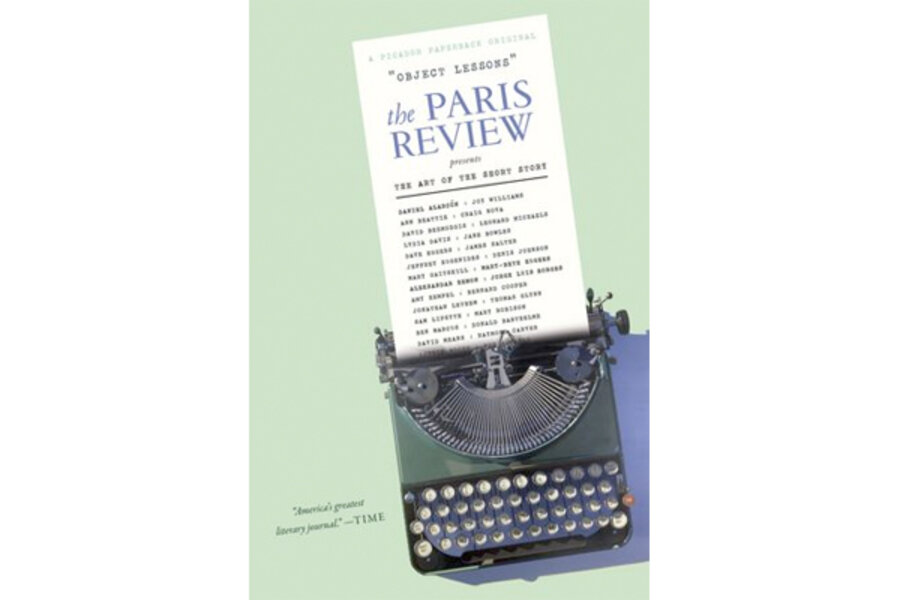Object Lessons
Loading...
Until I read Object Lessons: The Paris Review Presents the Art of the Short Story, I’d never heard of Jane Bowles, a sharp and witty mid-century writer whose output was hindered by alcoholism, mental illness, and a serious stroke at age 40. When Bowles died in 1973, at age 56, she had published only a short stack of fiction, and today, she is largely forgotten.
That’s too bad. One of Bowles’s seven short stories, “Emmy Moore’s Journal,” is reproduced in "Object Lessons," an anthology of stories originally published in The Paris Review, a journal that George Plimpton and some other American expatriates founded in 1953 as “a laboratory for new fiction.” Written shortly before Bowles’s death, the story describes the interior life of Moore, an insecure and possibly mentally ill woman who, for reasons that are unclear, has temporarily left her husband to stay in a lonely place called the Hotel Henry. I laughed at the character’s nonsensical but detailed ramblings even as I felt the urge to comfort her: “I am unusually feminine for an American of Anglo stock. (Born in Boston.) I am almost a ‘Turkish’ type. Not physically, at least not entirely, because though fat I have ruddy Scotch cheeks and my eyes are round and not slanted or almond-shaped. But sometimes I feel certain that I exude an atmosphere very similar to theirs (the Turkish women’s) and then I despise myself.”
"Object Lessons" was edited by Lorin Stein, the editor of the Review, and his deputy, Sadie Stein (no relation), but rather than selecting the stories themselves, they asked 20 contemporary authors to choose “a personal favorite” and to introduce it by explaining why it succeeds. Lydia Davis chose “Emmy Moore’s Journal,” and her thoughtful essay helped me – as a fan but not a writer of fiction – understand, sentence by sentence, the story’s power. The anthology is in fact intended for people like me, according to an Editors’ Note: “readers who are not (or, are no longer) in the habit of reading short stories,” but who are interested in better understanding them. “We hope these object lessons will remind them how varied the form can be, how vital it remains, and how much pleasure it can give.”
Readers of this kind may be discovering many of the authors in "Object Lessons" for the first time, as I was, and these discoveries were the greatest pleasure of the book for me. I cringed as I read “Lying Presences,” Norman Rush’s story from 1982 of two damaged adult brothers feuding over the present and the past, because both men – Jack, a compassion-challenged control freak, and Roy, an earnest scholar of UFOs – were so real. In “The Beau Monde of Mrs. Bridge,” published in 1955, Evan S. Connell movingly portrays the small, sad world of a stifled Kansas City housewife who’s trying to better herself. “She decided to vote liberal at the next election, and as time for it approached she became filled with such enthusiasm and anxiety that she wanted very much to discuss government with her husband. She began to feel confident that she could persuade him to change his vote also... However when she challenged him to discussion he did not seem especially interested, in fact he did not answer. He was watching a television acrobat stand on his thumb in a bottle and only glanced across at her for an instant with an annoyed expression.” Connell eventually published two novels based on these characters, "Mrs. Bridge," in 1959, and "Mr. Bridge," in 1969, which were made into a movie in 1990.
I had a hard time getting through a few of the stories. The very first one, “Dimmer,” which experimental writer Joy Williams published in 1969, is beautifully told, like a poem, but so thick with images that I often lost her thread; perhaps I could have navigated this challenging 35-page story better had Daniel Alarcón, who selected it, provided a meatier introduction, but it’s just a paragraph. Several of the other introductions in the book were similarly unsatisfying.
And why put “Dimmer” at the beginning of a collection aimed at literary outsiders, where it might scare some people off? The stories are ordered alphabetically by the writer introducing them rather than chronologically by date of publication, which would have made more sense.
The stories are indeed varied in their style, as the editors’ note promises, but many of them left me with the same feeling: devastation. In “Likely Lake,” Mary Robison shows us a man reckoning with his son’s death and the divorce that followed. In “Pelican Song,” Mary-Beth Hughes tells of a daughter who tries but fails to save her mother from an abusive husband.
By the end of the book, I was bracing myself, but still rapt.
Olivia Gentile is the author of "Life List."








